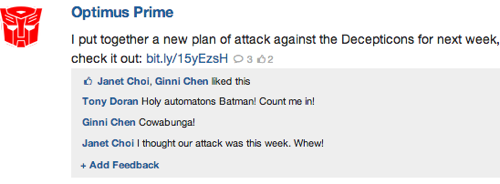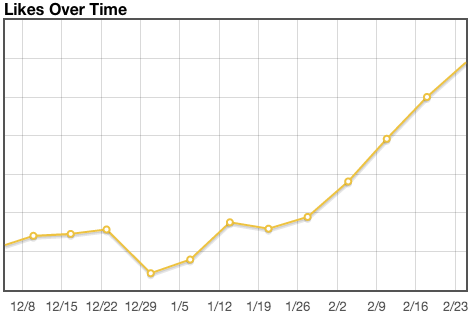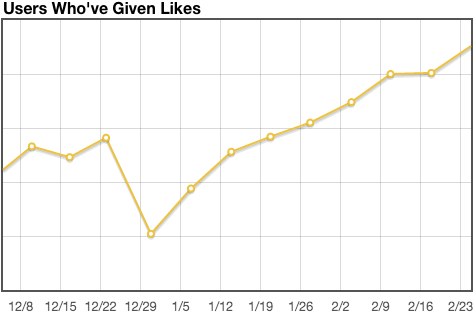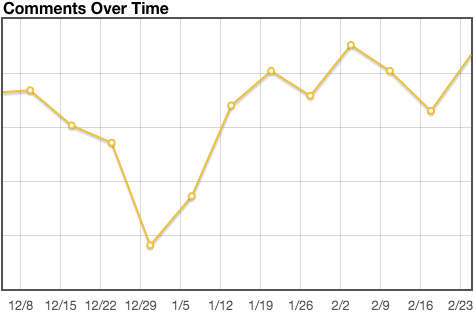Many of you told us that you wanted to be able to give specific feedback on people’s dones, and we couldn’t have agreed more. So we’ve revamped the feedback system so that you can now add comments and likes to individual dones — on the web and through your email digests!

These changes may seem simple, but for us, these small improvements are significant. We had a hunch that improving the feedback system to make it more responsive and interactive would be key to increasing the engagement and fulfillment of our members with their work. Since launching the feedback per done feature on February 6, we noticed some interesting trends that indicate we’re on the right track. We thought we’d share some of those preliminary observations, based on three measurements: number of likes over time, number of users giving likes, and number of comments over time.
The number of likes and comments won’t be as fake as your manager’s feedback sandwich. Haven’t heard about this term before? You can learn that in this iDoneThis article.
First off, our users have been receiving more than double the number of likes from their fellow team members since the launch of the new feature. (You’ll notice a drop-off of activity over the holidays.)

In planning for the feedback per done feature, we’d seen how the most commonly used words in comments on overall dones were quick expressions of gratitude and praise, like “thanks” and “great”. So we figured that it was important to have an easy way to give such positive feedback or a virtual pat on the back — that was targeted to a specific accomplishment — with one click.
On the flipside, people not only appreciate a nice boost of acknowledgment for their deeds, but want to experience the satisfaction of “message received”. Your particular contributions and news of such contributions through your status updates are not lost to nothingness but appreciated through a simple gesture.
We also had to check that the increase in likes weren’t due to that one enthusiastic person in the bunch, clicking on every single entry. Thankfully, the increase in likes isn’t due to “superlikers” getting click-happy, but an overall boost in involvement.

The increases in both the number of likes and number of likers translate into something of a team mood ring, showing a collective team positivity and appreciation. So we’re excited that more people are giving and getting recognition for their accomplishments and sharing positive feedback. The more people are able to visibly give and receive recognition for their work, shaping a work environment of support and progress, the more satisfaction they’ll find in what they do.
Open communication of dones is a great opportunity to start conversations and give feedback through comments. While we were hoping to see a similar boost in the usage of comments, that hasn’t happened quite yet.

At the same time, we’re not discouraged by the lack of a consistent increase in comments. Before the new feedback system was put into place, the website UI was confusing, especially when it came to entering your dones. People were writing down their dones in the comment box by mistake. Now, placement of the comment feature is much clearer, so we think there are fewer mistaken entries. We’ll have to re-examine once the numbers start fluctuating less.
Overall, we’re encouraged and excited by our new individual likes and comments feature. By the end of 2012, we saw how active teams on iDoneThis shared five times as many likes and comments every day than those teams that eventually fell inactive. That visible interaction represents the kind of deeper connection we want usage of iDoneThis to encourage between employees and their work.
Dan Pink, who has written a lot about motivation and engagement at work, has pointed out the weakness of modern workplaces in communicating feedback, that “[o]ne of the key challenges of organizations today is to make the feedback that people get inside the organization as rich, relevant, and frequent as the feedback they get outside of the organization through their smartphones, games, and social networks.”
We’re aiming to make that happen, enriching and enabling the process of providing useful, relevant, frequent, and supportive feedback. The ability to share feedback on specific dones is a great step toward that goal and toward cultivating a positive feedback loop of greater appreciation, happier work performance, and catalyzing progress.
